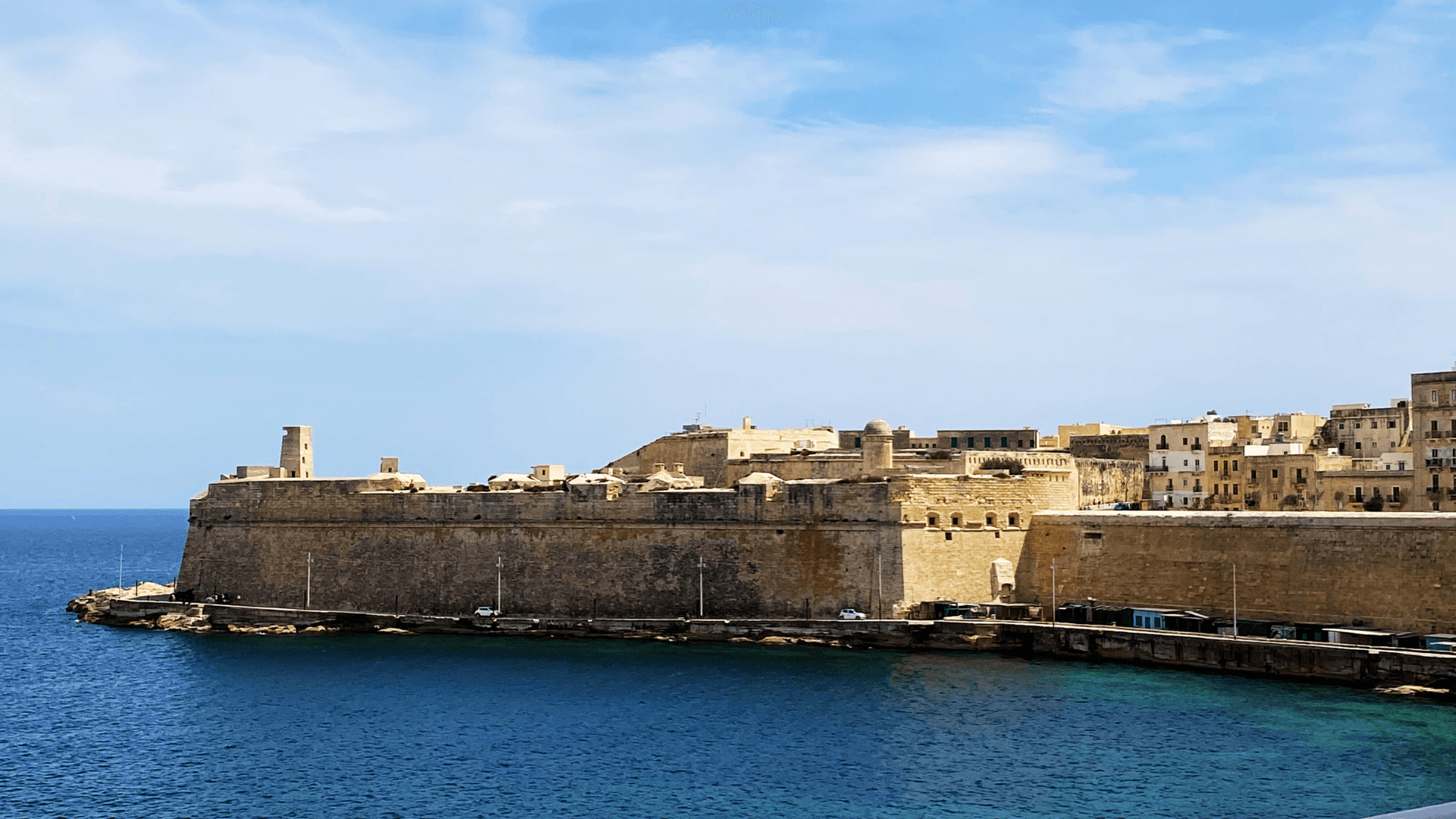Valletta in Malta - What to See and Explore?

Valletta, the capital of Malta, is a beautiful city rich in history, culture, and architecture. Located on a peninsula and surrounded by the sea, the city is a UNESCO World Heritage Site and one of Europe's smallest capitals. If you are planning a holiday in Malta, be sure to visit this city and see what it has to offer, we were truly captivated by it.
If you are traveling with a stroller, try to bring a lighter pushchair, as you will often have to carry it to conquer dozens of steps and navigate between tables set up on narrow streets. In many places, there is no alternative.
Traveling with teenagers and a small child, we opted primarily for a long walk with well-deserved breaks for lunch and ice cream. 😉
We visited Malta's capital in April, and despite being off-season, Valletta was bustling with life, souvenir stalls, dozens of restaurants, and guides approaching tourists to sell boat trips or mini train rides.
15 degrees and pleasant sunshine are ideal conditions to discover this beautiful city.
Valletta, How to Get There?
Buses in Malta
Malta Public Transport (MPT) offers many connections between various towns on the island, including between the airport and the capital. Tickets can be purchased at the airport counters or directly on the bus. Ticket prices depend on the route and usually range from 2 to 3 euros per person, allowing for 2 hours of travel (including transfers).
You can check the route on Google Maps, there is no need to install local apps.
Unfortunately, do not rely on the timetables, even off-season, we often waited dozens of minutes for a bus that was supposed to arrive every few minutes.
Buses that are full do not stop at the stops (or only drop off passengers).
Remember that if you see a bus approaching the stop, you should wave to let the driver know you are waiting for it.
The bus will take you to the Triton Fountain, a landmark located right at the city's gates.
Taxi and Uber in Malta
If you are looking for a faster and more comfortable way to get to Valletta, a taxi may be a good choice. At the airport and various points in Malta, you will find many taxi companies, and Uber and Bolt also work well. Prices are usually set based on the tariff, which depends on the route and time of day. For example, a ride from the airport to Valletta costs about 25 euros.
Ferry
Another option is to travel by ferry from Italy, Sicily, or Tunisia. Malta has several ports, including the port in Marsaxlokk, located about 8 km southeast of Valletta. Connections are available from cities such as Palermo, Salerno, Genoa, and Tunis. Ferries offer different classes of cabins and dining options on board.
The History of Valletta
Valletta was founded in 1566 by the Order of the Knights of St. John as a defensive site against Muslim attacks. Within a few years, the city became a powerful fortress that achieved many victories in wars with the Ottoman Empire. In the 19th century, Malta became a British colony, and Valletta became the island's capital. After gaining independence in 1964, Valletta remained the capital of Malta.
Valletta - What to Visit?
Valletta is a city with plenty to see and do. Here are some of the top attractions worth visiting:
Valletta Gate - The gate to Valletta, also known as the City Gate, is an impressive structure that has protected the entrance to Malta's capital for centuries. The gate to Valletta is one of the most important tourist attractions in Malta's capital. Not only does it protect the entrance to the city, but it has also witnessed many historical events. The gate can be found at the western end of Sciberras Peninsula, on Gran Via Jean de Valette, and its view is one of the most distinctive in the city.
When was the Gate to Valletta built?
The gate was built in the 17th century, in 1633, at the command of Grand Master Jean de Valette. It was part of a fortification complex designed to protect the city from enemy attacks. The gate also served as a checkpoint for people entering and leaving the city. Over the centuries, the gate has been renovated and improved several times. In the 18th century, two clock towers were added, which still adorn the entrance to the city today. In the 20th century, the gate underwent a thorough renovation, during which its facade was restored, and the clock mechanisms were renewed.
The Gate to Valletta has many interesting facts and anecdotes associated with its history. Here are a few:
In the 18th century, during the fighting between the Maltese and French troops, French General Napoleon Bonaparte ordered the gate to be demolished. However, due to the resilience of the structure, he eventually gave up and left Malta.
The Gate to Valletta is adorned with the coat of arms of Grand Master Jean de Valette, who had it built. The coat of arms depicts two crosses - the symbol of the Order of St. John, of which de Valette was a member.
The clocks on the Gate to Valletta were built by Maltese watchmaker Giorgio Azzopardi. The clocks show hours, minutes, seconds, and the phase of the moon.
Fort Saint Elmo - Located at the northern end of the peninsula, Fort Saint Elmo is one of the most important historical sites in the city. It was built in 1565 and played a key role in defending the city from Muslim attacks.
St. John's Co-Cathedral - Built in the 18th century, St. John's Co-Cathedral is one of the most important monuments in the city. It is the resting place of the Knights of St. John and one of the most magnificent Baroque churches in Europe.
Upper Barrakka Gardens - Located on a high cliff overlooking Grand Harbour, these gardens are an ideal place to relax and enjoy the beautiful city panorama.
National Museum of Fine Arts - Located in Palazzo Falson, the museum houses a collection of art, furniture, and other items from various historical periods.
Valletta – What to Do with Children?
The Malta Experience - This interactive museum allows you to learn about Malta's history in an engaging way. With virtual technology, children and adults will have the opportunity to learn about Malta's history in a unique way.
Playmobil FunPark - This amusement park is a paradise for Playmobil toy fans.
Valletta - How to See the Cannon Firing?
The cannon firing is one of Valletta's most characteristic traditions, the capital of Malta. Every day at 12:00 and 16:00, gunners at the Saluting Battery square fire salutes to celebrate the city's centuries-old history and remind of its military past. The tradition of cannon firing dates back to the 18th century when Malta was a British colony. At that time, salutes were fired on the clock signal from Fort St. James to signal the hour for ships in the port. With the development of technology and new time signaling methods, the tradition of cannon firing gradually faded but was revived in the 1990s as a tourist attraction.
It's worth arriving 20 minutes early, as many tourists gather to hear the loud shot.
Hastings Garden
Just after crossing the city gate, you can turn left and go up the stairs.
Hastings Gardens is a beautiful park located in the center of Malta's capital, Valletta. It is one of the most popular places for walks and relaxation for city residents and tourists. The park is situated on a hill, offering a wonderful view of Grand Harbour and the surrounding area. Currently, the park covers an area of about 2000 m² and offers many attractions for visitors.
In Hastings Gardens, there are several old trees, but also a variety of ornamental plants, such as figs, jasmine, hibiscuses, and palms, giving a sense of exoticism. The park is also rich in monuments and sculptures, including the statue of Sir Alexander Ball, who was the British governor of Malta in the 19th century.
One of the most characteristic features of Hastings Gardens is the viewing terrace, which offers a spectacular view of Grand Harbour and the surrounding area. You can see shipyards, fortifications, and even a few islands. At night, the view is equally beautiful, thanks to the city and port lighting.
The park is an ideal place for a picnic, a walk, or reading a book in the shade of trees. Hastings Gardens has a café where you can buy ice cream and fruit drinks in addition to coffee.
Valletta - How Much Does Food Cost?
Food prices in Valletta primarily depend on the type of restaurant and the dishes chosen. In Malta's capital, you can find restaurants with different standards and prices, ranging from cheaper fast foods and bistros to exclusive venues with exquisite dishes.
The average cost of a meal in a restaurant in Valletta ranges from 10 to 20 EUR for a main course.
Regarding drink prices, coffee or tea costs between 1.5 to 3 EUR, and beer averages 3-5 EUR per bottle. Wines and cocktails are significantly more expensive and can cost from 7 EUR. For 5 meals and non-alcoholic drinks in a restaurant on the main street, we paid 108 euros + tip. The dishes were okay, nothing remarkable 😉
How Much Time is Needed to Explore Valletta?
One full day is definitely the minimum time to get to know this city.
If you want to take boat trips to Silema or visit all the museums (which is probably impossible), you'll easily find activities for a whole week here.
Read also:

